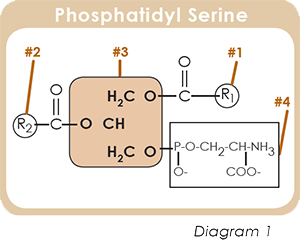Seriphos Chemistry
Phosphatidyl Serine when consumed in food, for example egg yolks, or in a capsule provides about 20% of active Phosphorylated Serine (see #4 in Diagram 1). Each 100 mg of Phosphatidyl Serine yields about 20 mg of active Phosphorylated Serine following consumption. The bulk of the weight is derived from two fatty acids, RI & R2, shown in Diagram 1.
In the intestinal tract, the various enzymes (brush border and pancreatic) clip off the fatty acids, predominantly the unsaturated fatty acids (RI & R2 in diagram). These fatty acids are not reassembled in the body to the stump molecule, rather different fatty acids are attached by the body to replace RI and R2.
The shaded glycerol molecule (shaded area #3 in Diagram 1) is very abundant in the body because it is found in all body fat and in dietary fats/oils. In brief, the Phosphatidyl Serine acts as a precursor molecule and is not the active form of this nutrient. In our tissues, the rate limiting step is the phosphorylation of the serine molecule (see #4 in Diagram 1).
In contrast, Phosphorylated Serine (brand name, SERIPHOS®) provides the activated or Phosphorylated Serine (see #4 in Diagram 1) in a chelate form of magnesium and calcium.
In the local tissue, the Phosphorylated Serine is linked to glycerol and the appropriate fatty acids specific to each tissue, and is not linked to the fatty acids provided in the precursor Phosphatidyl Serine.
Phosphorylated Serine (brand name, SERIPHOS®) is a pure product not derived from animal tissue. The serine is from vegetable sources and the phosphate is from a pure phosphate donor compound.
Excerpts & Abstracts on the Use of Phosphorylated Serine
* Early Cortisol Escape Phenomenon Reversed by Phosphatidyl Serine In Elderly Normal Subjects. Nerozzi, Dina et al, Clinical Trials Journal, I•89, vol 26.
Summary
The early cortisol escape phenomenon observed after administration of 1 mg of dexamethasone in 50% of the elderly subjects in the study was reversed by two months therapy with Phosphatidyl Serine (PS), 3 x100 mg tablets daily.
An action of the compound at the neurotransmitter level is hypothesized.
A number of alterations of the **HPAA was detectable in our study in normal elderly subjects; abnormal elevation of basal morning cortisol values (3 subjects); disruption of the circadian cortisol pattern (4 subjects); early cortisol escape phenomenon observed in seven of our subjects. A true nonsuppression was visible only in two individuals. Therefore, the early cortisol escape phenomenon appears to be the most consistent abnormality found in our subjects.
The question of contribution of non-specific stress factors to cortisol hypersecretion obviously cannot be ruled out. However, in our opinion, an intrinsic neuro-endocrine disturbance, which may be part of a central dysfunction associated with aging, could be at the root of a substantial part of the hypersecretion.
According to the membrane hypothesis of aging,(1) age-dependent changes of the membranes can negatively interfere with trophism of the neurons, with cell to cell communication and ultimately with neurotransmission and thus with most
functions linked to neurotransmission, including hormonal secretion. According to Massarotti,(2) PS seems to stimulate some sort of morphogenetic neuronal plasticity, which acts as a compensatory adaptive mechanism to cell deterioration, and is capable of preventing or delaying the age dependent decline of neurotransmitter function. On the basis of our findings we can speculate that existence of an analogous mechanism which acts on neurotransmission similar to that observed in animals treated with PS.
However, when we consider the impairment of HPAA as a marker of a more central neurotransmitter imbalance, we can suppose that the re-adjustment of such an altered parameter, although partial, may be brought about by some action at the neurotransmitter level.
1. Sund & Sun, Top. Geront., 1979; 15:34-53.
2. Massarotti. M. In: Bes A, ed. Senile Dementias. Effects of Phosphatidyl Serine in Age Associated Memory Impairment T.H. Crook. Ph.D.; J. Tinklenberg. MD; J. Yesavage,MD; W. Petrie, ML); M.G. Nunzi, Ph.D; and D.C. Massari, Ph.D.; Neurology, 1991; 41:611-649.
Summary
We treated 149 patients meeting criteria of age associated memory impairment (AAMI) for 12 weeks with a formulation of Phosphatidyl Serine (100-150mg PS bid) or placebo.
Patients treated with the compound improved, relative to those untreated, with learning and memory tasks of daily life.
Analysis of clinical subgroup suggested that persons within the sample who performed at a relatively low level prior to treatment were most likely to respond to PS. Within this subgroup, there was improvement on both computerized and
standard neuropsychological performance tests, and also on clinical global ratings of improvement. The results suggest that the compound may be a promising candidate for treating memory loss in later life.
| Brand Name | Sold By | Economic considerations | Active Phosphorylated serine content | Stability | Remarks |
|---|---|---|---|---|---|
| PhosSerine and other brand names | Various companies | Retails $40.00 per 60 capsules | About 20 mg per capsule Form: Phosphatidyl Serine Precursor molecule. | Contains fatty acids that can oxidize during storage. | Absorption depends on digestion efficiency of user. |
| Daily cost at 3 per day is $2.00 | |||||
| 1 bottle lasts 20 days | |||||
| SERIPHOS | InterPlexus, Inc. | Retails $26.00 per 100 capsules | About 90 mg per capsule Form: Phosphatidyl Serine Active molecule. | No fatty acids. Does not oxidize. Long Shelf life. | Absorption does not depend on enzyme availability in G.I. tract of user. |
| Daily cost at 3 per day is $0.78 | |||||
| 1 bottle lasts 33 days |
** HPAA: Hypothalmic Pituitary Adrenal Axis
